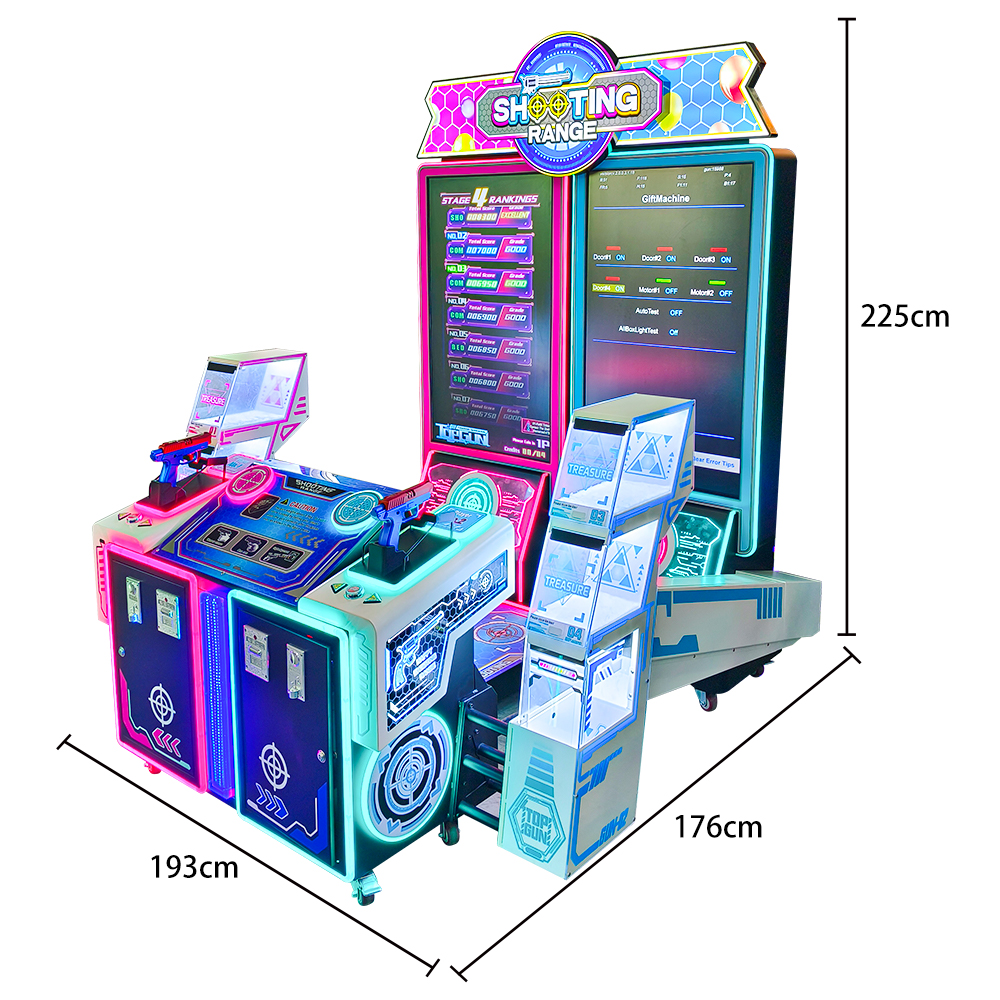Arcade games gained popularity due to their affordable, accessible entertainment and the social atmosphere they created, drawing millions weekly.
Table of Contents
ToggleIntroduction
The explosive growth of video game arcades in the late 20th century followed the technological boom that coincided with momentous social exploration of the era. Originally, these coin operated games could be found in dedicated arcade centers and public spaces which included shopping centers and movie theaters.
Technological Catalysts
The popularity of arcade games was largely because of the rapid improvements in technology. By the early ’70s, games like “Pong” were recognizable landmarks not for their gripping gameplay, but because they offered a new dimension of graphical powers that, while by all accounts primitive nowadays, were cutting edge at the time. The early 1970s jump in technology was nothing compared to the late 1970s breakthrough in color graphics and deeper game-play when “Space Invaders” was further released. But by the mid-1980s, titles like “Pac-Man” and “Donkey Kong” were displaying graphics that were far more elaborate and gameplay that had greater depth, appealing to a broader demographic. This time period produced an unprecedented amount of technology that helped game developers expand their horizons and create innovative experiences that could attract larger audiences.
The Social Scene
Arcades were even trendy as social centers, not just for their games. Before the Internet, there were only a few places where young people could converge, socialize, and play: arcades. This social element was key, the fact that someone could walk into an arcade and play against another person and go for the records on a cab placed in a public setting. Just where this stunning multiplayer added appeal was cemented for many by tournaments and a competitive streak added to the proceedings.
Economic Accessibility
Arcade games offered a comparison to the more expensive forms of entertainment during the recession times of the late 1970s and early 1980s. Cheap thrills for a price that anyone could afford was thus available to the masses. The arcade’s economic model heavily relied on its ability to draw in foot traffic and getting players to play their games repeatedly, which allowed them to stay profitable.
Cultural Impact
The influence of arcade games on popular culture is a hefty one, shaping the likes of music, movies, television and so many other forms of fashion. Cultural icons like Pac-Man were soon being merchandised into other media and all over the world. Arcade games have influenced more than just entertainment, but helped to sculpt the visual and digital culture of a generation.

Technological Innovations
It was the evolution of gaming technology that really sparked the explosion of arcade game popularity. They were not just steps forward, they were steps into the interactive entertainment of a new era. Arcades were animated by an endless succession of technological leaps adding layers of complexity and appeal, bringing new fans to the findament.
From Monochrome to Multicolor
The shift from monochrome to color at the end of the 1970s was equally important. Then games like “Galaxian” in 1979 came along, with its colorful graphics being hardly comparable to “Pong” released in 1972. There are free spins bonus symbols that can trigger free spins of several other amazing features alongside better visual assets such as graphics and animations that set a new standard for these games that made them interesting to play, easy to identify among other slots, more entertaining and fun to play for longer periods for a large number of audiences.
Sound Innovation
The sound technology has also been improved. Arcade games before the early 1980s were typically in monotonic sound however, the first arcade video game to have used a continuous background soundtrack was Rally-X, released by Namco in 1980,Godzilla and TOYPANEL, released by Namco in 1982,first used a video game playmode mainly based on a dancing style. For example, games such as “Pac-Man” (1980) and “Donkey Kong” (1981) were among the first to include genuine music and sound effects which were viewed as a necessary part of the general gaming experience. The improve audio literally blew the mind of anyone who was playing the games at this time-it was taking the already immersive world of Sega gameplay and shedding a tiny layer of superfluous skin off.
Introduction of CPU
The use of microprocessors to integrate the game revolutionized arcade game development. The first game to use a microprocessor was the 1975 Gun Fight, which had a joystick; its CPU was a Texas Instruments 4-bit computer. This leap in tech meant developers had the capability of making larger, more complex games, which opened the gates for genres and gameplay to exist than ever before.
Control Mechanisms
Another huge factor was the progression of game controls. Then console changed from basic button controls to e.g. trackballs and joysticks, which allowed for new types of challenges and ways of playing the game. For example, “Missile Command” (1980) and “another game” used a new trackball system for input, allow more precise and more faster input over using a joystick at that time, and this use the new technology to reinforce the narrative of the game, making a better game experience.
Social Dynamics
Throughout the late 20th century, the arcade game became a social phenomenon and a major form of entertainment. Out of this emerged the social environment of arcades, a key part of what made them popular to begin with: they offered a communal space where people could mingle and play against each other.
Arcades as Social Hubs
What occurred with time is that the arcades transformed from places of gaming to active social places that people especially teens and young adults visit. When arcades were at the height of their popularity in the early 1980s, it is estimated that over 4 million people were visiting arcades every week in the U.S. This provided a community of people who shared common interests with one another in an age before the world-wide web brought us social media.
Competitive Play and High Score Chases
Arcade games were intended to create a competitive climate. More so than in simply ending the game, the players most demonstrated interest in how they compared against others: their friends or others who went to the arcade. Classic games such as Pac-Man and Space Invaders had high score tables that helped introduce a competitive level of play that encouraged gamers to get better and show off in front of other gamers. In turn, arcades further popularized video games as a pastime, and created a competitive pursuit of high scores that would bring players back time and again, either to challenge friends or on their own in the hope of beating an existing high score.
Multiplayer and Cooperative Games
The addition of multiplayer and co-op game types only served to enhance this social experience. Games like “Double Dragon” and “Gauntlet” – that let two or more folks jump in and either work together or try to kill each other – became standard in arcades. These games were designed as a social, multiplayer experience that was entertaining to all family members, building a sense of community and a level of competitiveness that would make each gaming session its own, memorable event.
Impact of Arcade Tournaments
Arcade competitions also reinforced the social arm of play. Competitive gaming communities were developed around individual titles, including popular titles such as Street Fighter II and Starcraft II. You could say that these were some of the early forms of what we now call esports focused on player skill and strategy.

Economic Factors
Several other key economic factors were new to the marketplace that also played a role in the explosive success of arcade games in the late 20th-century. Arcade games attracted consumers for a few reasons, a few of them listed above; which in essence were building a sustainable business for operators.
Affordable Entertainment
In times of economic recession, such as the early 1980s, arcade games became a source of relatively inexpensive entertainment. Players put up usually a quarter at the beer stand and enjoy the game for peanuts, a bargain compared to whatever other amusements might have beckoned. This cost-effectiveness was essential during those disposable-income scarce time frames. By the end of 1981, it is estimated that arcades were becoming very productive, with annual revenues of over $8 billion nationwide, (an enormous sum in 1980) underscored by the popularity of Space Invaders as well as Pac-Manas income generators pulling from more traditional retail stores.
The Business Model of Arcades
The concept of the arcade was simple and two-fold: find a game that would be so fun that it would draw consistent crowds with friends and develop some form of competitive spirit to keep pumping quarters. This model was advantageous in part due to machines’ minimal upkeep costs and higher number of players. The arcades ranged in price from $2,000 to $3,000, but when maintained they could generate as much as $400 a week, providing a quick return on investment for operators.
Multiplier Effect of Popular Games
A hit title wasn’t just a source of income – it was a multiplier. Arcades were busy places because of hit games like Pac-Man and Space Invaders, which caused owners to buy those games by the handful. These games would tend to get the premium position on the arcade floor and hence get more plays and hence more total spends on the floor
Role of Game Developers and Distributors
Game developers and distributors were a key part of the arcade game ecology as well. So they kept things feeling fresh with a healthy mix of new titles and followups of existing hits. This continuous renewal, in turn, had players coming back for more. In addition, profit sharing often encouraged developers to work with arcade operators, and for those developers and operators to each prioritize the maximization of things like game utilization and revenue.
Influence of Pop Culture
Arcade games were more than just a way to pass the time they helped shaped popular culture, affecting its music, its movies, its everything. Arcade games now had to compete with what folks could play at homeThe growth of arcade games wasn’t good for everyone.
TV And Movie Video Games
Arcades very often featured in movies or TV-series, as the coolest thing in the 80s. Movies such as Tron (1982) and WarGames (1983) were among the first to feature arcade games as major objects of a film as well as influencing movies with the use of gaming culture. Treating them as such was a massive part of both their cultural importance and their broad appeal; a reinforcement that helped make their portrayal seamless in the worlds they existed side by side with.
Merchandising and media synergies
Meanwhile, characters like Pac-Man, Mario, and Donkey Kong from games blazed trails from the screen to everyday life through merchandise, including clothing, lunchboxes, and animated TV. This then helped drive a few other spin-offs of the culture-defining 80s, the most noteworthy being that Pac-Man would go on to become an animated television series(Pac-Man, the show) and a hit single (‘Pac-Man Fever,’ the hit #9 on the billboard hot 100 in 1982) which highlights just how big of a deal this game was culturally.
Influence on Music and Art
Trends in music and visual art were also influenced by arcade games, and ideas for music based on games could also be found in each of these forms. 8-bit chiptune was a genre of electronic music, and it took the 8-bit tones of the sound melodies in arcade games as a source. Pixel art style was becoming a trend among artists and they started to redraw all of this both in digital as well as traditional art. This later crossover appeal reveals the wide purchase of the aesthetics of the arcade past of gaming.
Cultural Iconography
The visuals and sounds from arcade games became legendary in 80s pop culture. Not only were the bleeps and bloops from arcade games a sound that was instantly recognizable but soon they were associated with an entire generation. Hey remember ‘Space Invaders’ and ‘Pac-Man”: how they instantly made you feel crappy for missing the Eighties.
Evolution of Gaming
Arcade games like Pong were incredibly popular and changed the way people spent their free time and forever influenced the evolution of the gaming industry. The things that these platforms pioneered, the ideas that would impact game development for decades.
Port The BR Game Mechanic
Arcade games were the first to implement intricate gameplay mechanics and deeper stories. While early arcade games were simple, games also began to become more complex as technology and programming knowledge improved. For example, by using laser disc technology, ‘Dragon’s Lair’ (1983) had more detailed graphics and video-quality animation (at the time) elsewhere, fundamentally shaping the design of games to come.
Home Game Console Foundation
The popularity of arcade games single-handedly gave birth to the concept of home gaming consoles. It was the demand for the arcade experience in the home that inspired the creation of increasingly powerful gaming systems. The strong sales of ‘Pac-Man’ and its conversion to the Atari 2600 of also gave a shot in the arm for the for the company and showed that converting arcade hits over to home consoles was a viable strategy. This change paved the way for the console wars of the late 80s and 90s, and expanded the gaming market.
New Game Methodology and Technology
Arcade games were also important as they moved video game technology and design forward. This spawned a successful industry with millions of players who powered arcade innovation before the hardware was miniaturised for home consoles. Here are the games you may have played while back then, and how you helped introduce concepts into gaming that are now essential, such as competition and leveling up.
Cultural Inflection Point on Interactive Entertainment
Video and arcade games helped pioneer an entire cultural shift to interactive entertainment that would lay the institutional groundwork for the modern video game industry. And that vision came to pass as arcades’ fast, frenetic gameplay caught the public’s imagination, paving the way for interactive media to become both more accepted and more embraced by the populace. This change was very instrumental in molding the entertainment choices and habits of consumption worldwide.








